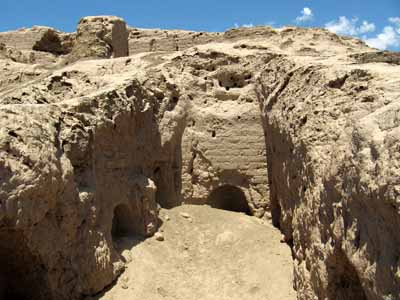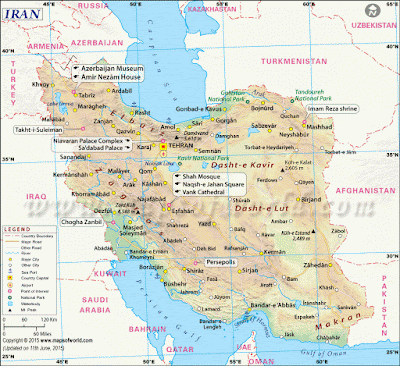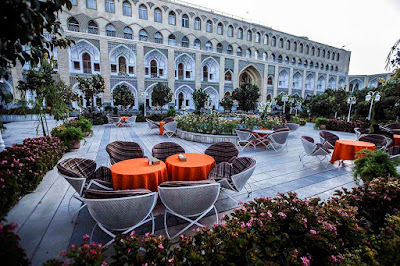From
Janpiq Qala we proceeded forty-eight miles as the crow flies downstream to the no-account city of
Nukus, which I had visited before and certainly did not want to visit again. Hurrying through Nukus we crossed the Amu Darya River and drove about twenty-five miles southwest to the immense burial grounds of Mizdakhan. Apparently there was a settlement on this site as far back as the fourth century b.c. when Khwarezm was freeing itself from the Persian Achaemenid Empire. This original settlement was destroyed by fire around the end of the second century b.c. Another settlement existed here between the first and fourth centuries a.d. but it too was eventually destroyed by agents unclear. Around the second century b.c. a cemetery was established here and after the settlements disappeared the area eventually became devoted to burials. Between the fifth and eight centuries it became an important Zoroastrian burial site with many ossuaries containing bones which had been had stripped of their flesh at places like the
Tower of Silence which I had visited earlier. There are also some Christian burials here dating to the seventh century. These probably involve members of the Melkite sect who had settled in Khwarezm. Interestingly they had apparently adopted Zoroastrian burial customs and interred the bones of their dead in ossuaries.
In 712 a.d. the Islamic Arabs conquered the area, destroying many of the local Zoroastrian fire temples and killing Zoroastrian priests. Zoroastrian burials continued until about the ninth century, however, indicating that the Arabs had not been able to immediately stamp out Zoroastrianism. The first Muslim burials date to around the ninth century. From then on the necropolis grew exponentially. I have not seen any figures on how many tombs are in the necropolis, but there are certainly thousands and perhaps tens of thousands. Many people with the means to do so built mausoleums the size of houses.
Among the notables is the tomb of Shamun Nabi. According to legend the tomb of this well-known local holy man, like the Tomb of Khizr in Samarkand, continues to get longer each year. It is already over 50 feet long and supposedly still growing!
The seven-domed mausoleum of Shamun Nabi (click on photos for enlargements)
The ever-growing tomb of Shamun Nabi
Not far from the tomb of Shamun Nabi is the Mazlum Sulu Khan Mausoleum. This is especially interesting since it dates back to the time of the last Khwarezmshahs, either Tekesh (r. 1172–1200) or his son Mohammed (r. 1200–1220), at the end of the twelfth century or the beginning of the thirteenth. Thus it was quite new when the Mongols arrived in the area in the winter of 1220–1221. It is usually kept locked, but an old caretaker appeared out of nowhere and offered to open it up for my inspection. He did not speak English but we were able to communicate in Russian.
The mausoleum is fairly unusual in that it is underground. It was a blistering 85º F outside but walking down the steps into the main room of the mausoleum was like entering an air-conditioned hotel room. The caretaker said it stays cool throughout even the hottest days of summer. The cupola over the underground room may have been destroyed during the Mongol invasion but it was later rebuilt and the mausoleum eventually became an important pilgrimage site. Still later it became a hangout for shamans. According to a legend retold by
Khwarezm Qala Cognoscente David Richardson, the mausoleum is named after the daughter of an important local official, apparently back when the mausoleum was built:
Mazlum Sulu Khan was supposedly the beautiful daughter of the governor of Mizdahkan. Despite being desired by all of the local eligible bachelors, Mazlum Sulu Khan was in love with a poor builder. Frustrated by the lack of a suitable groom, the governor foolishly announced that he would give his daughter’s hand to the young man who could build a minaret as tall as the sky in the space of one night. Naturally the poor builder succeeded in constructing the minaret, but when he came to the palace for the hand of his bride the following morning, the governor refused. The dejected young man jumped from the top of the minaret only to be followed by the beautiful and distraught Mazlum Sulu Khan. The heartbroken governor ordered that the minaret be destroyed. The young lovers were buried together and a mausoleum was constructed above their grave using the bricks from the ruins of the minaret.
This, however, is supposedly only a legend, and it remains unclear for whom the mausoleum was actually built. But if it is just a legend then who is buried in the small tombs on which someone has placed artificial flowers? I tried to get more information from the caretaker, but bizarrely enough as soon as he found out I was an American he launched into a long monologue about the ex-boxer Mike Tyson. Unfortunately, my Russian was not up to grasping his point. This is the fifth or sixth time I have heard about Mike Tyson in Uzbekistan. Next to Obama he appears to be the best known American in the country. The only other person who comes close is Beyoncé.
Entrance to the underground chamber
Underground chamber with a tomb decorated with flowers
Underground chamber with a tomb decorated with flowers
View of the dome over the underground chamber
Another tomb with flowers. Who is actually buried here is unknown.
Madrassa destroyed by Amir Timur when he swept through Khwarezm in1388. The bricks stacked in what looks like tiny ovoos adds a peculiarly Mongolian touch to the scene.
City of the Dead:These are all tombs
City of the Dead
City of the Dead
City of the Dead
City of the Dead
Just a mile or so from the necropolis are the ruins of Gyaur Qala, not to be confused with the
Gyaur Qala farther upstream on the Amu Darya. It was destroyed by Chingis Khan’s sons Ögedei and Chagatai in the winter of 1220-1221 either before or after they sacked the Khwarezm capital of Urgench, fifteen miles or so to the southwest. I would of course love to visit Urgench (now Konye Urgench) but it is on the other side of the border in Turkmenistan and I do not have a visa for Turkmenistan.
Ruins of Gyaur Qala











































